Entrepreneurial Growth: Impact of Knowledge, SMEs, and Acquisitions
VerifiedAdded on 2023/01/19
|8
|1660
|99
Essay
AI Summary
This essay delves into the multifaceted concept of entrepreneurial growth, emphasizing the pivotal role of Small and Medium Enterprises (SMEs) in driving economic progress. It highlights the significance of knowledge acquisition, particularly from international markets, in fostering growth and market development, with a focus on how entrepreneurial orientation moderates the relationship between planning, scanning, and international conduct. The essay examines the impact of entrepreneurial acquisitions on SMEs, including their motivations, antecedents, and organizational outcomes. It also explores the interplay between organizational learning capability, entrepreneurial orientation, and SME growth, as well as the influence of entrepreneurial skills on job creation and market expansion. The acquisition of entrepreneurial knowledge and skills has assisted the SMEs to understand the global market and competitive strategies. SMEs have also implemented the entrepreneurial knowledge from other developing SMEs in other countries leading to economic growth and creation of employment.
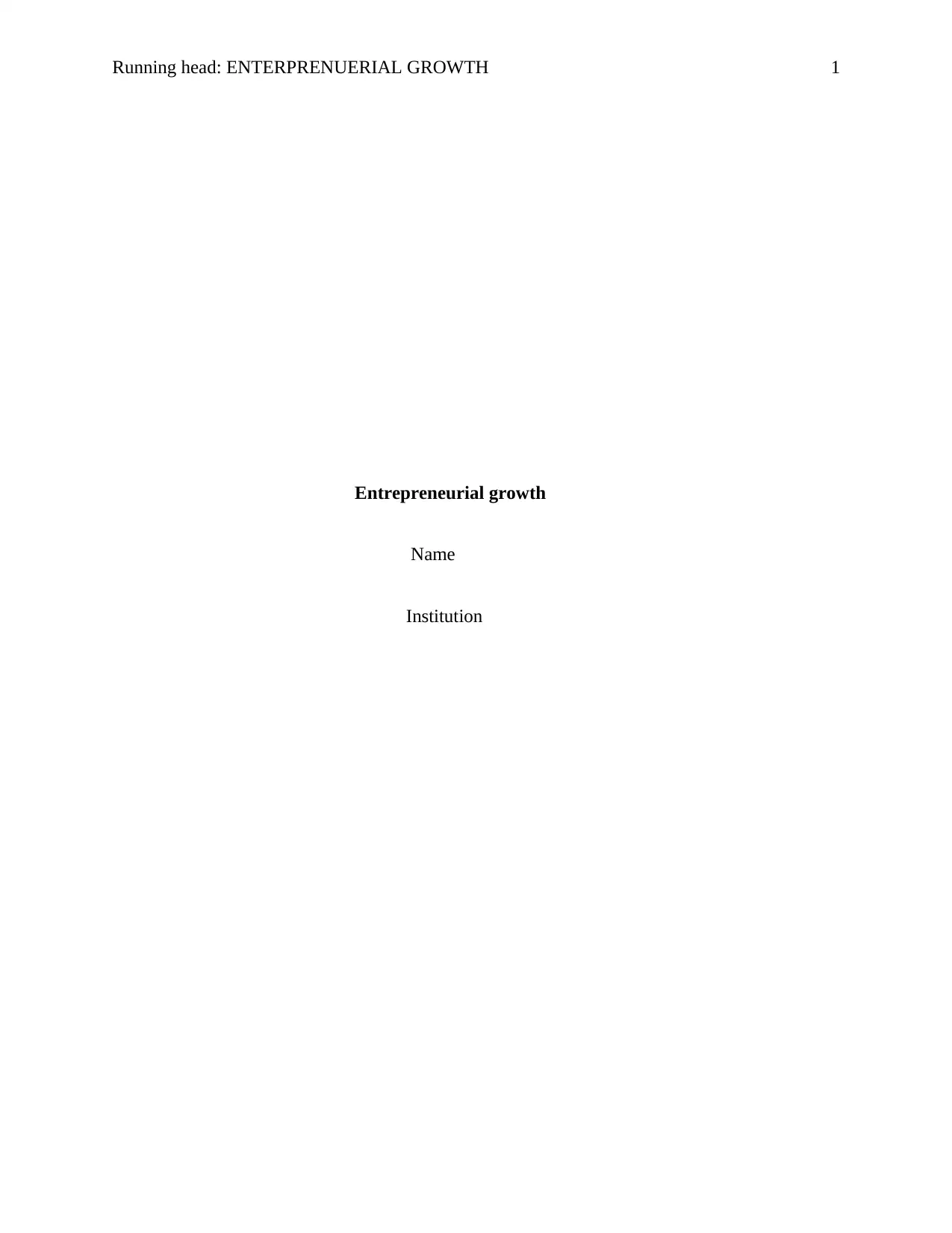
Running head: ENTERPRENUERIAL GROWTH 1
Entrepreneurial growth
Name
Institution
Entrepreneurial growth
Name
Institution
Paraphrase This Document
Need a fresh take? Get an instant paraphrase of this document with our AI Paraphraser
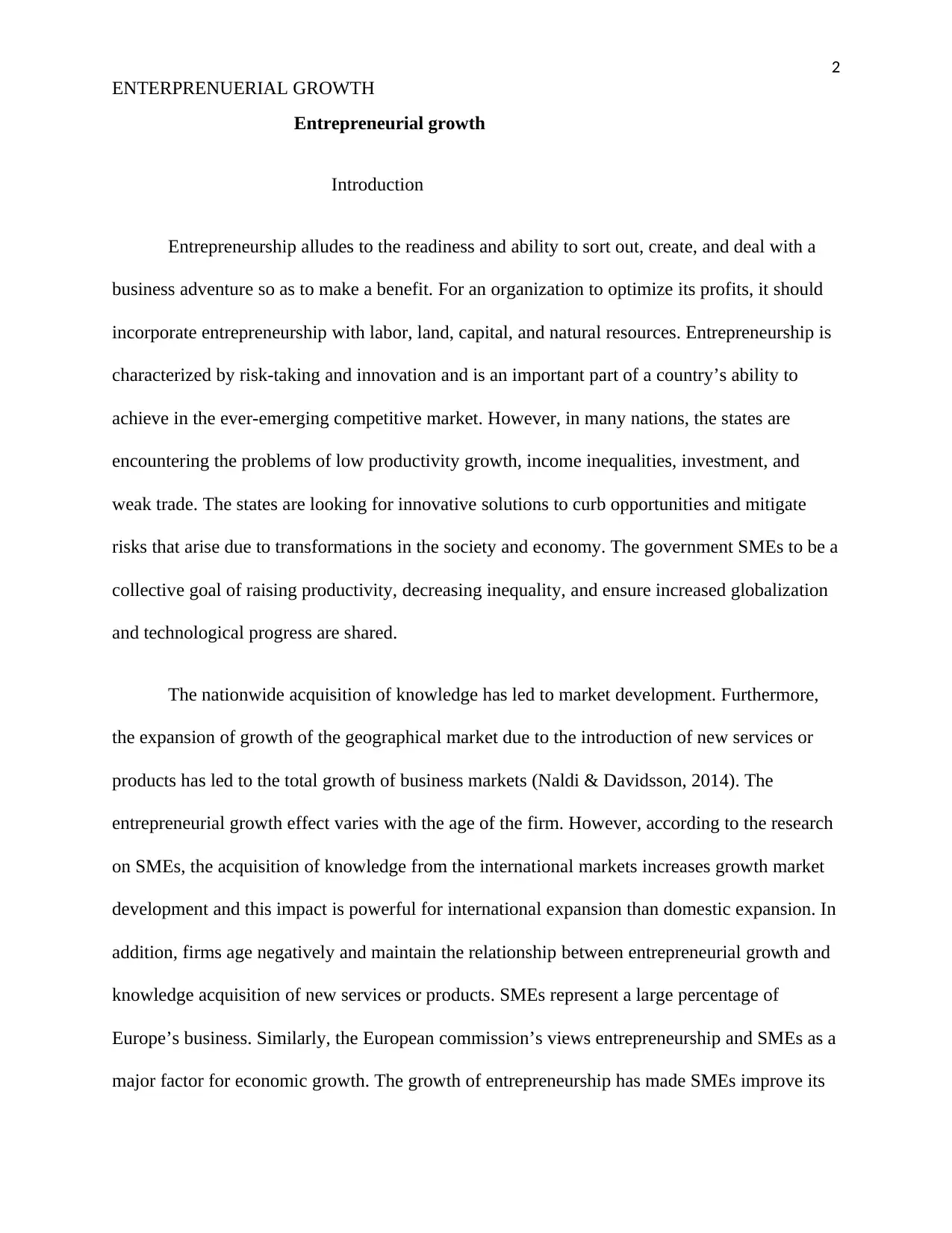
2
ENTERPRENUERIAL GROWTH
Entrepreneurial growth
Introduction
Entrepreneurship alludes to the readiness and ability to sort out, create, and deal with a
business adventure so as to make a benefit. For an organization to optimize its profits, it should
incorporate entrepreneurship with labor, land, capital, and natural resources. Entrepreneurship is
characterized by risk-taking and innovation and is an important part of a country’s ability to
achieve in the ever-emerging competitive market. However, in many nations, the states are
encountering the problems of low productivity growth, income inequalities, investment, and
weak trade. The states are looking for innovative solutions to curb opportunities and mitigate
risks that arise due to transformations in the society and economy. The government SMEs to be a
collective goal of raising productivity, decreasing inequality, and ensure increased globalization
and technological progress are shared.
The nationwide acquisition of knowledge has led to market development. Furthermore,
the expansion of growth of the geographical market due to the introduction of new services or
products has led to the total growth of business markets (Naldi & Davidsson, 2014). The
entrepreneurial growth effect varies with the age of the firm. However, according to the research
on SMEs, the acquisition of knowledge from the international markets increases growth market
development and this impact is powerful for international expansion than domestic expansion. In
addition, firms age negatively and maintain the relationship between entrepreneurial growth and
knowledge acquisition of new services or products. SMEs represent a large percentage of
Europe’s business. Similarly, the European commission’s views entrepreneurship and SMEs as a
major factor for economic growth. The growth of entrepreneurship has made SMEs improve its
ENTERPRENUERIAL GROWTH
Entrepreneurial growth
Introduction
Entrepreneurship alludes to the readiness and ability to sort out, create, and deal with a
business adventure so as to make a benefit. For an organization to optimize its profits, it should
incorporate entrepreneurship with labor, land, capital, and natural resources. Entrepreneurship is
characterized by risk-taking and innovation and is an important part of a country’s ability to
achieve in the ever-emerging competitive market. However, in many nations, the states are
encountering the problems of low productivity growth, income inequalities, investment, and
weak trade. The states are looking for innovative solutions to curb opportunities and mitigate
risks that arise due to transformations in the society and economy. The government SMEs to be a
collective goal of raising productivity, decreasing inequality, and ensure increased globalization
and technological progress are shared.
The nationwide acquisition of knowledge has led to market development. Furthermore,
the expansion of growth of the geographical market due to the introduction of new services or
products has led to the total growth of business markets (Naldi & Davidsson, 2014). The
entrepreneurial growth effect varies with the age of the firm. However, according to the research
on SMEs, the acquisition of knowledge from the international markets increases growth market
development and this impact is powerful for international expansion than domestic expansion. In
addition, firms age negatively and maintain the relationship between entrepreneurial growth and
knowledge acquisition of new services or products. SMEs represent a large percentage of
Europe’s business. Similarly, the European commission’s views entrepreneurship and SMEs as a
major factor for economic growth. The growth of entrepreneurship has made SMEs improve its
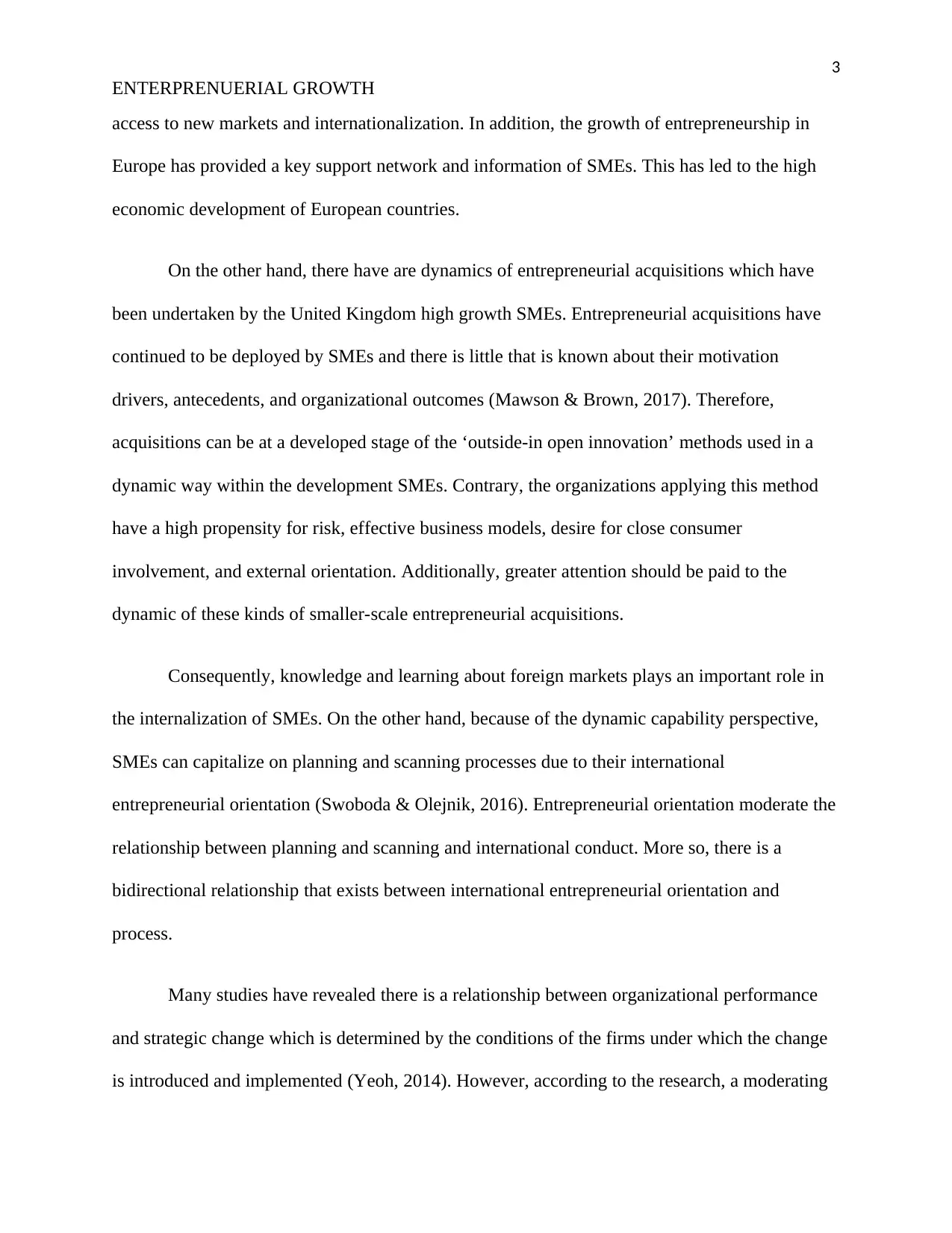
3
ENTERPRENUERIAL GROWTH
access to new markets and internationalization. In addition, the growth of entrepreneurship in
Europe has provided a key support network and information of SMEs. This has led to the high
economic development of European countries.
On the other hand, there have are dynamics of entrepreneurial acquisitions which have
been undertaken by the United Kingdom high growth SMEs. Entrepreneurial acquisitions have
continued to be deployed by SMEs and there is little that is known about their motivation
drivers, antecedents, and organizational outcomes (Mawson & Brown, 2017). Therefore,
acquisitions can be at a developed stage of the ‘outside-in open innovation’ methods used in a
dynamic way within the development SMEs. Contrary, the organizations applying this method
have a high propensity for risk, effective business models, desire for close consumer
involvement, and external orientation. Additionally, greater attention should be paid to the
dynamic of these kinds of smaller-scale entrepreneurial acquisitions.
Consequently, knowledge and learning about foreign markets plays an important role in
the internalization of SMEs. On the other hand, because of the dynamic capability perspective,
SMEs can capitalize on planning and scanning processes due to their international
entrepreneurial orientation (Swoboda & Olejnik, 2016). Entrepreneurial orientation moderate the
relationship between planning and scanning and international conduct. More so, there is a
bidirectional relationship that exists between international entrepreneurial orientation and
process.
Many studies have revealed there is a relationship between organizational performance
and strategic change which is determined by the conditions of the firms under which the change
is introduced and implemented (Yeoh, 2014). However, according to the research, a moderating
ENTERPRENUERIAL GROWTH
access to new markets and internationalization. In addition, the growth of entrepreneurship in
Europe has provided a key support network and information of SMEs. This has led to the high
economic development of European countries.
On the other hand, there have are dynamics of entrepreneurial acquisitions which have
been undertaken by the United Kingdom high growth SMEs. Entrepreneurial acquisitions have
continued to be deployed by SMEs and there is little that is known about their motivation
drivers, antecedents, and organizational outcomes (Mawson & Brown, 2017). Therefore,
acquisitions can be at a developed stage of the ‘outside-in open innovation’ methods used in a
dynamic way within the development SMEs. Contrary, the organizations applying this method
have a high propensity for risk, effective business models, desire for close consumer
involvement, and external orientation. Additionally, greater attention should be paid to the
dynamic of these kinds of smaller-scale entrepreneurial acquisitions.
Consequently, knowledge and learning about foreign markets plays an important role in
the internalization of SMEs. On the other hand, because of the dynamic capability perspective,
SMEs can capitalize on planning and scanning processes due to their international
entrepreneurial orientation (Swoboda & Olejnik, 2016). Entrepreneurial orientation moderate the
relationship between planning and scanning and international conduct. More so, there is a
bidirectional relationship that exists between international entrepreneurial orientation and
process.
Many studies have revealed there is a relationship between organizational performance
and strategic change which is determined by the conditions of the firms under which the change
is introduced and implemented (Yeoh, 2014). However, according to the research, a moderating
⊘ This is a preview!⊘
Do you want full access?
Subscribe today to unlock all pages.

Trusted by 1+ million students worldwide
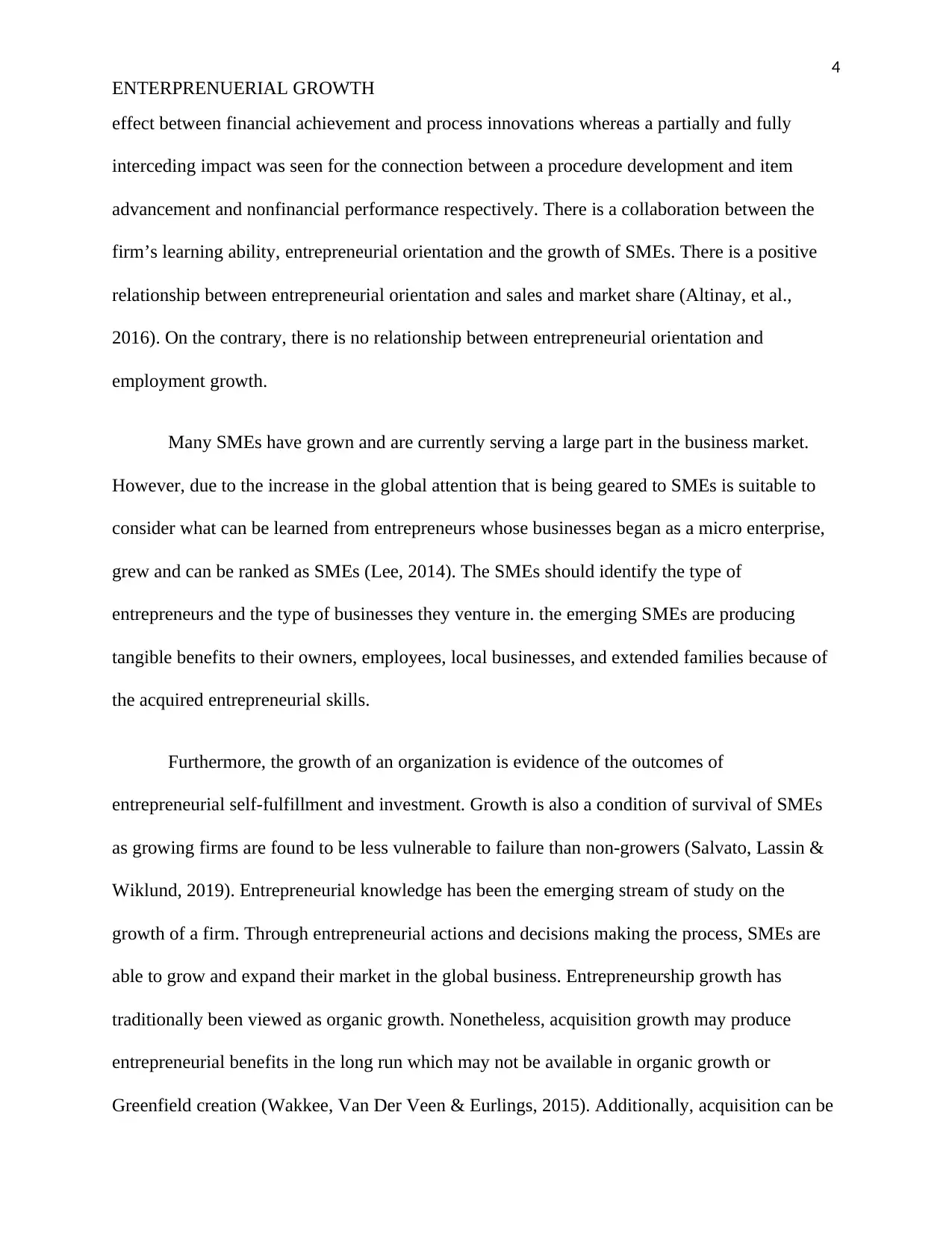
4
ENTERPRENUERIAL GROWTH
effect between financial achievement and process innovations whereas a partially and fully
interceding impact was seen for the connection between a procedure development and item
advancement and nonfinancial performance respectively. There is a collaboration between the
firm’s learning ability, entrepreneurial orientation and the growth of SMEs. There is a positive
relationship between entrepreneurial orientation and sales and market share (Altinay, et al.,
2016). On the contrary, there is no relationship between entrepreneurial orientation and
employment growth.
Many SMEs have grown and are currently serving a large part in the business market.
However, due to the increase in the global attention that is being geared to SMEs is suitable to
consider what can be learned from entrepreneurs whose businesses began as a micro enterprise,
grew and can be ranked as SMEs (Lee, 2014). The SMEs should identify the type of
entrepreneurs and the type of businesses they venture in. the emerging SMEs are producing
tangible benefits to their owners, employees, local businesses, and extended families because of
the acquired entrepreneurial skills.
Furthermore, the growth of an organization is evidence of the outcomes of
entrepreneurial self-fulfillment and investment. Growth is also a condition of survival of SMEs
as growing firms are found to be less vulnerable to failure than non-growers (Salvato, Lassin &
Wiklund, 2019). Entrepreneurial knowledge has been the emerging stream of study on the
growth of a firm. Through entrepreneurial actions and decisions making the process, SMEs are
able to grow and expand their market in the global business. Entrepreneurship growth has
traditionally been viewed as organic growth. Nonetheless, acquisition growth may produce
entrepreneurial benefits in the long run which may not be available in organic growth or
Greenfield creation (Wakkee, Van Der Veen & Eurlings, 2015). Additionally, acquisition can be
ENTERPRENUERIAL GROWTH
effect between financial achievement and process innovations whereas a partially and fully
interceding impact was seen for the connection between a procedure development and item
advancement and nonfinancial performance respectively. There is a collaboration between the
firm’s learning ability, entrepreneurial orientation and the growth of SMEs. There is a positive
relationship between entrepreneurial orientation and sales and market share (Altinay, et al.,
2016). On the contrary, there is no relationship between entrepreneurial orientation and
employment growth.
Many SMEs have grown and are currently serving a large part in the business market.
However, due to the increase in the global attention that is being geared to SMEs is suitable to
consider what can be learned from entrepreneurs whose businesses began as a micro enterprise,
grew and can be ranked as SMEs (Lee, 2014). The SMEs should identify the type of
entrepreneurs and the type of businesses they venture in. the emerging SMEs are producing
tangible benefits to their owners, employees, local businesses, and extended families because of
the acquired entrepreneurial skills.
Furthermore, the growth of an organization is evidence of the outcomes of
entrepreneurial self-fulfillment and investment. Growth is also a condition of survival of SMEs
as growing firms are found to be less vulnerable to failure than non-growers (Salvato, Lassin &
Wiklund, 2019). Entrepreneurial knowledge has been the emerging stream of study on the
growth of a firm. Through entrepreneurial actions and decisions making the process, SMEs are
able to grow and expand their market in the global business. Entrepreneurship growth has
traditionally been viewed as organic growth. Nonetheless, acquisition growth may produce
entrepreneurial benefits in the long run which may not be available in organic growth or
Greenfield creation (Wakkee, Van Der Veen & Eurlings, 2015). Additionally, acquisition can be
Paraphrase This Document
Need a fresh take? Get an instant paraphrase of this document with our AI Paraphraser
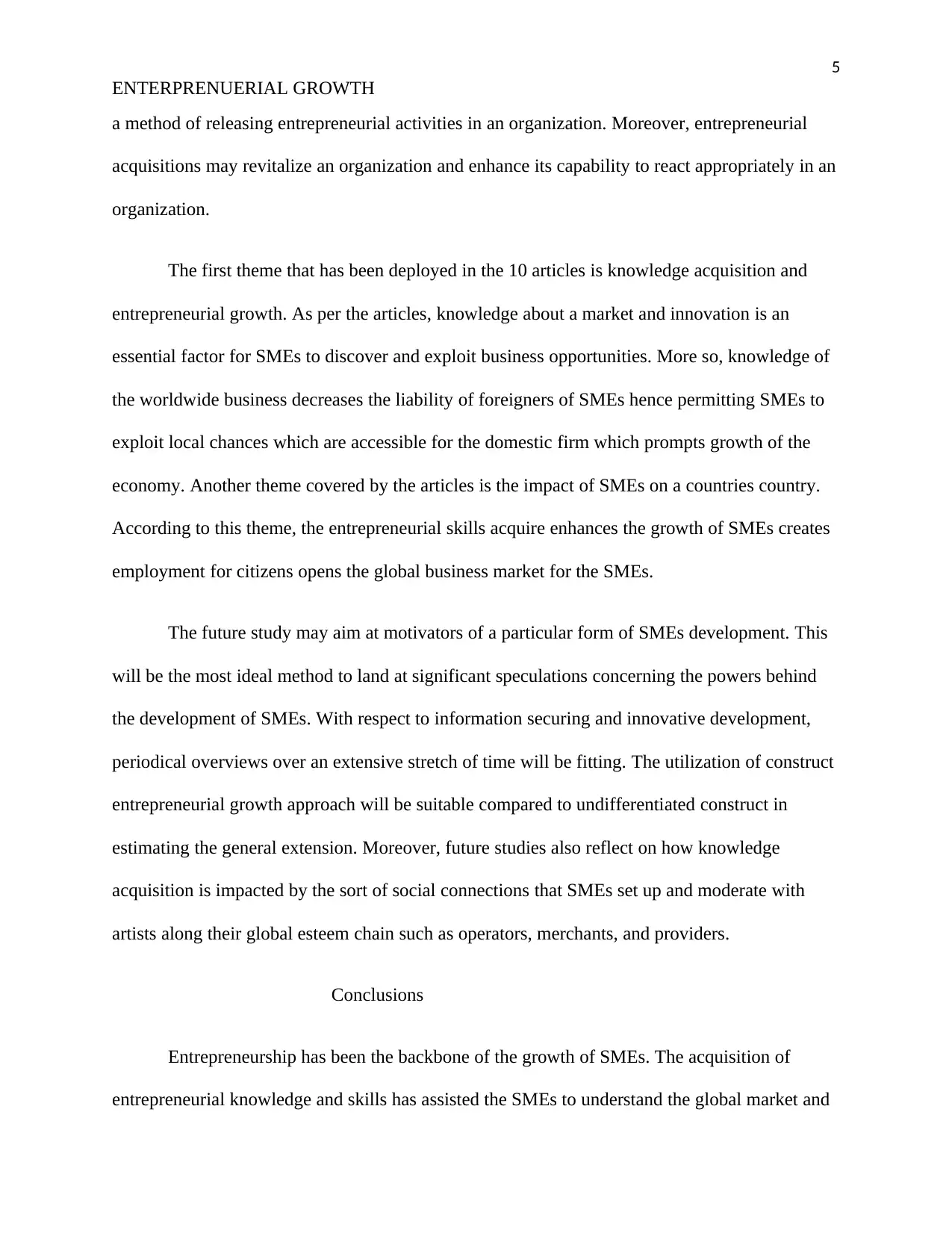
5
ENTERPRENUERIAL GROWTH
a method of releasing entrepreneurial activities in an organization. Moreover, entrepreneurial
acquisitions may revitalize an organization and enhance its capability to react appropriately in an
organization.
The first theme that has been deployed in the 10 articles is knowledge acquisition and
entrepreneurial growth. As per the articles, knowledge about a market and innovation is an
essential factor for SMEs to discover and exploit business opportunities. More so, knowledge of
the worldwide business decreases the liability of foreigners of SMEs hence permitting SMEs to
exploit local chances which are accessible for the domestic firm which prompts growth of the
economy. Another theme covered by the articles is the impact of SMEs on a countries country.
According to this theme, the entrepreneurial skills acquire enhances the growth of SMEs creates
employment for citizens opens the global business market for the SMEs.
The future study may aim at motivators of a particular form of SMEs development. This
will be the most ideal method to land at significant speculations concerning the powers behind
the development of SMEs. With respect to information securing and innovative development,
periodical overviews over an extensive stretch of time will be fitting. The utilization of construct
entrepreneurial growth approach will be suitable compared to undifferentiated construct in
estimating the general extension. Moreover, future studies also reflect on how knowledge
acquisition is impacted by the sort of social connections that SMEs set up and moderate with
artists along their global esteem chain such as operators, merchants, and providers.
Conclusions
Entrepreneurship has been the backbone of the growth of SMEs. The acquisition of
entrepreneurial knowledge and skills has assisted the SMEs to understand the global market and
ENTERPRENUERIAL GROWTH
a method of releasing entrepreneurial activities in an organization. Moreover, entrepreneurial
acquisitions may revitalize an organization and enhance its capability to react appropriately in an
organization.
The first theme that has been deployed in the 10 articles is knowledge acquisition and
entrepreneurial growth. As per the articles, knowledge about a market and innovation is an
essential factor for SMEs to discover and exploit business opportunities. More so, knowledge of
the worldwide business decreases the liability of foreigners of SMEs hence permitting SMEs to
exploit local chances which are accessible for the domestic firm which prompts growth of the
economy. Another theme covered by the articles is the impact of SMEs on a countries country.
According to this theme, the entrepreneurial skills acquire enhances the growth of SMEs creates
employment for citizens opens the global business market for the SMEs.
The future study may aim at motivators of a particular form of SMEs development. This
will be the most ideal method to land at significant speculations concerning the powers behind
the development of SMEs. With respect to information securing and innovative development,
periodical overviews over an extensive stretch of time will be fitting. The utilization of construct
entrepreneurial growth approach will be suitable compared to undifferentiated construct in
estimating the general extension. Moreover, future studies also reflect on how knowledge
acquisition is impacted by the sort of social connections that SMEs set up and moderate with
artists along their global esteem chain such as operators, merchants, and providers.
Conclusions
Entrepreneurship has been the backbone of the growth of SMEs. The acquisition of
entrepreneurial knowledge and skills has assisted the SMEs to understand the global market and

6
ENTERPRENUERIAL GROWTH
competitive strategies. SMEs have also implemented the entrepreneurial knowledge from other
developing SMEs in other countries leading to economic growth and creation of employment.
ENTERPRENUERIAL GROWTH
competitive strategies. SMEs have also implemented the entrepreneurial knowledge from other
developing SMEs in other countries leading to economic growth and creation of employment.
⊘ This is a preview!⊘
Do you want full access?
Subscribe today to unlock all pages.

Trusted by 1+ million students worldwide
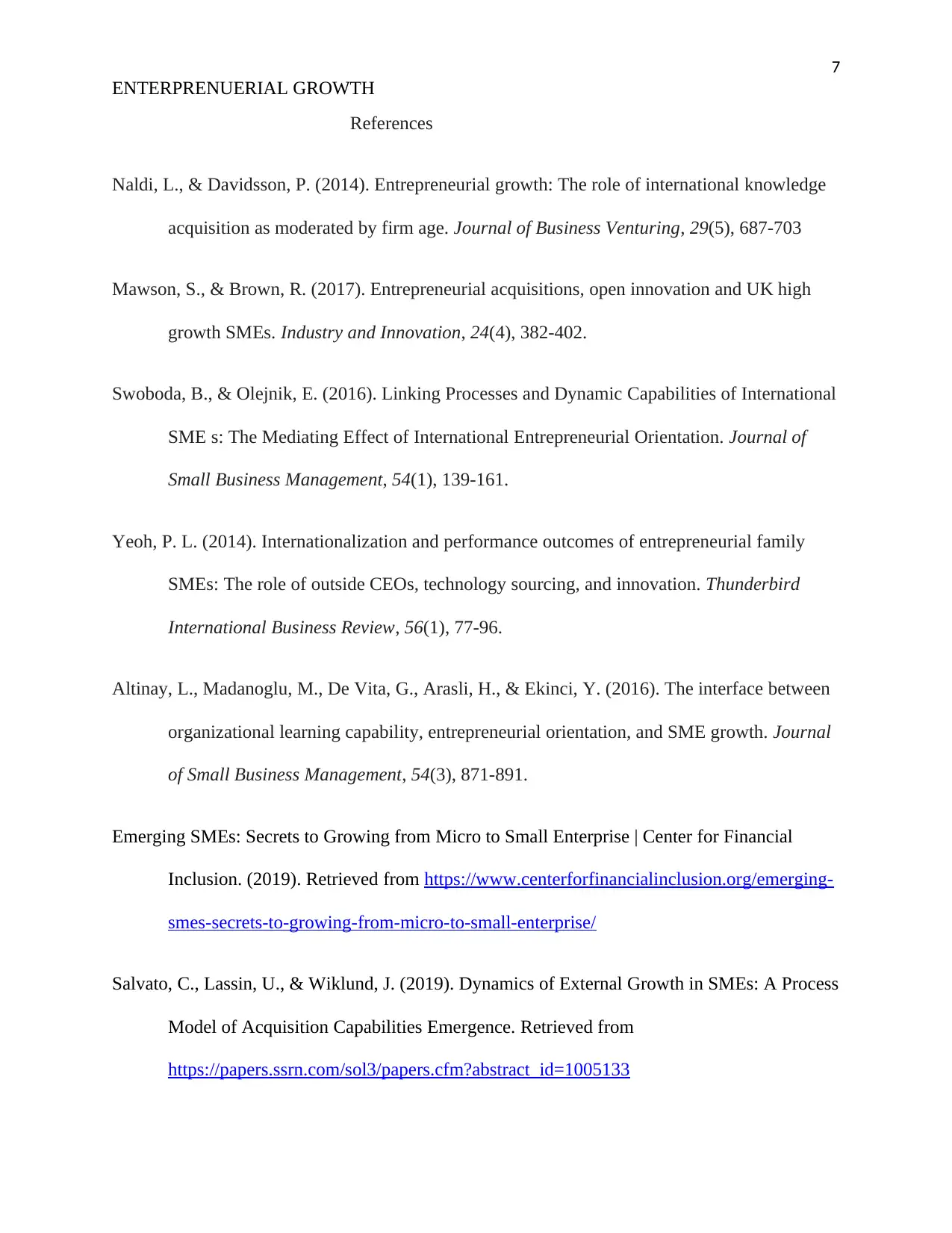
7
ENTERPRENUERIAL GROWTH
References
Naldi, L., & Davidsson, P. (2014). Entrepreneurial growth: The role of international knowledge
acquisition as moderated by firm age. Journal of Business Venturing, 29(5), 687-703
Mawson, S., & Brown, R. (2017). Entrepreneurial acquisitions, open innovation and UK high
growth SMEs. Industry and Innovation, 24(4), 382-402.
Swoboda, B., & Olejnik, E. (2016). Linking Processes and Dynamic Capabilities of International
SME s: The Mediating Effect of International Entrepreneurial Orientation. Journal of
Small Business Management, 54(1), 139-161.
Yeoh, P. L. (2014). Internationalization and performance outcomes of entrepreneurial family
SMEs: The role of outside CEOs, technology sourcing, and innovation. Thunderbird
International Business Review, 56(1), 77-96.
Altinay, L., Madanoglu, M., De Vita, G., Arasli, H., & Ekinci, Y. (2016). The interface between
organizational learning capability, entrepreneurial orientation, and SME growth. Journal
of Small Business Management, 54(3), 871-891.
Emerging SMEs: Secrets to Growing from Micro to Small Enterprise | Center for Financial
Inclusion. (2019). Retrieved from https://www.centerforfinancialinclusion.org/emerging-
smes-secrets-to-growing-from-micro-to-small-enterprise/
Salvato, C., Lassin, U., & Wiklund, J. (2019). Dynamics of External Growth in SMEs: A Process
Model of Acquisition Capabilities Emergence. Retrieved from
https://papers.ssrn.com/sol3/papers.cfm?abstract_id=1005133
ENTERPRENUERIAL GROWTH
References
Naldi, L., & Davidsson, P. (2014). Entrepreneurial growth: The role of international knowledge
acquisition as moderated by firm age. Journal of Business Venturing, 29(5), 687-703
Mawson, S., & Brown, R. (2017). Entrepreneurial acquisitions, open innovation and UK high
growth SMEs. Industry and Innovation, 24(4), 382-402.
Swoboda, B., & Olejnik, E. (2016). Linking Processes and Dynamic Capabilities of International
SME s: The Mediating Effect of International Entrepreneurial Orientation. Journal of
Small Business Management, 54(1), 139-161.
Yeoh, P. L. (2014). Internationalization and performance outcomes of entrepreneurial family
SMEs: The role of outside CEOs, technology sourcing, and innovation. Thunderbird
International Business Review, 56(1), 77-96.
Altinay, L., Madanoglu, M., De Vita, G., Arasli, H., & Ekinci, Y. (2016). The interface between
organizational learning capability, entrepreneurial orientation, and SME growth. Journal
of Small Business Management, 54(3), 871-891.
Emerging SMEs: Secrets to Growing from Micro to Small Enterprise | Center for Financial
Inclusion. (2019). Retrieved from https://www.centerforfinancialinclusion.org/emerging-
smes-secrets-to-growing-from-micro-to-small-enterprise/
Salvato, C., Lassin, U., & Wiklund, J. (2019). Dynamics of External Growth in SMEs: A Process
Model of Acquisition Capabilities Emergence. Retrieved from
https://papers.ssrn.com/sol3/papers.cfm?abstract_id=1005133
Paraphrase This Document
Need a fresh take? Get an instant paraphrase of this document with our AI Paraphraser
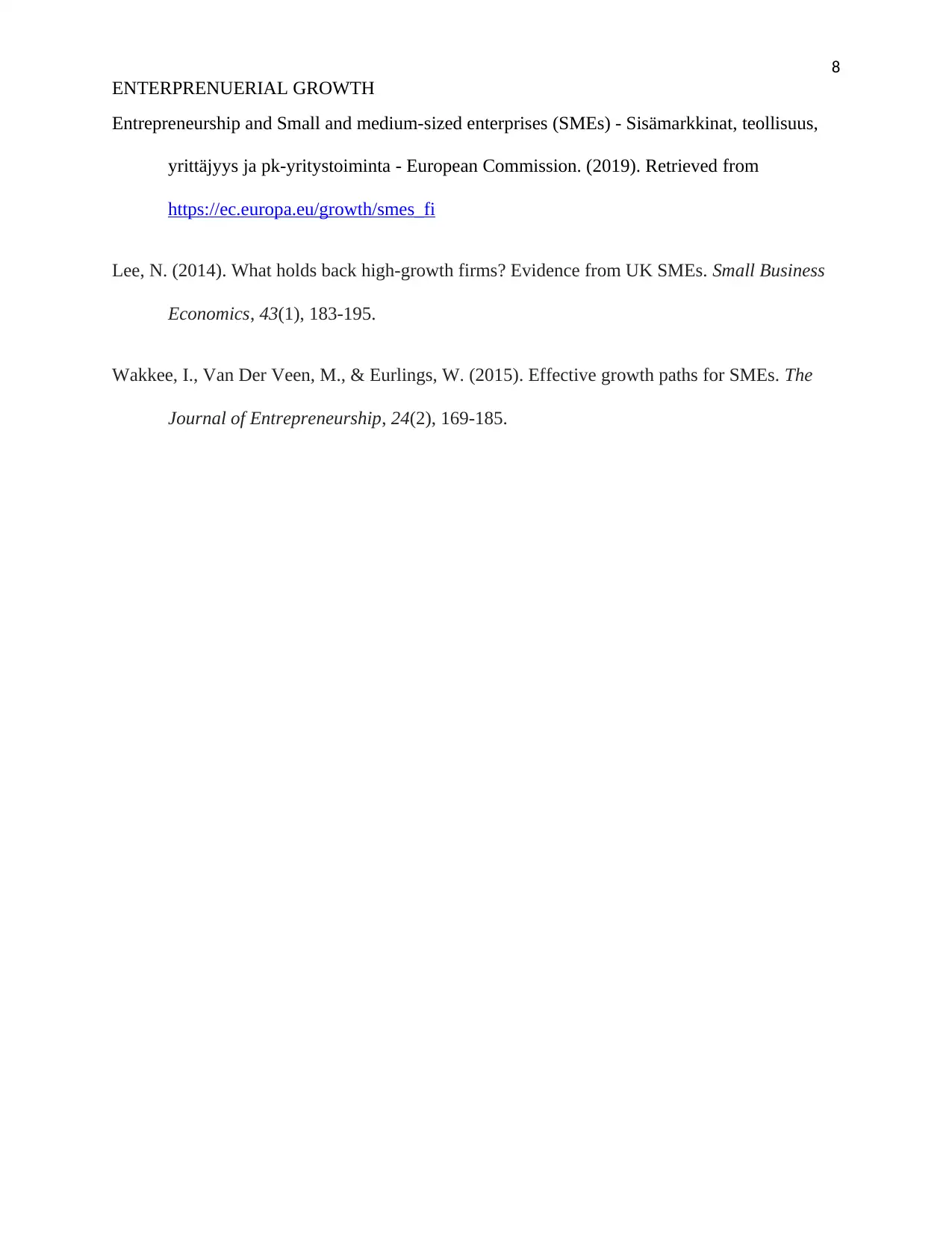
8
ENTERPRENUERIAL GROWTH
Entrepreneurship and Small and medium-sized enterprises (SMEs) - Sisämarkkinat, teollisuus,
yrittäjyys ja pk-yritystoiminta - European Commission. (2019). Retrieved from
https://ec.europa.eu/growth/smes_fi
Lee, N. (2014). What holds back high-growth firms? Evidence from UK SMEs. Small Business
Economics, 43(1), 183-195.
Wakkee, I., Van Der Veen, M., & Eurlings, W. (2015). Effective growth paths for SMEs. The
Journal of Entrepreneurship, 24(2), 169-185.
ENTERPRENUERIAL GROWTH
Entrepreneurship and Small and medium-sized enterprises (SMEs) - Sisämarkkinat, teollisuus,
yrittäjyys ja pk-yritystoiminta - European Commission. (2019). Retrieved from
https://ec.europa.eu/growth/smes_fi
Lee, N. (2014). What holds back high-growth firms? Evidence from UK SMEs. Small Business
Economics, 43(1), 183-195.
Wakkee, I., Van Der Veen, M., & Eurlings, W. (2015). Effective growth paths for SMEs. The
Journal of Entrepreneurship, 24(2), 169-185.
1 out of 8
Related Documents
Your All-in-One AI-Powered Toolkit for Academic Success.
+13062052269
info@desklib.com
Available 24*7 on WhatsApp / Email
![[object Object]](/_next/static/media/star-bottom.7253800d.svg)
Unlock your academic potential
Copyright © 2020–2025 A2Z Services. All Rights Reserved. Developed and managed by ZUCOL.



